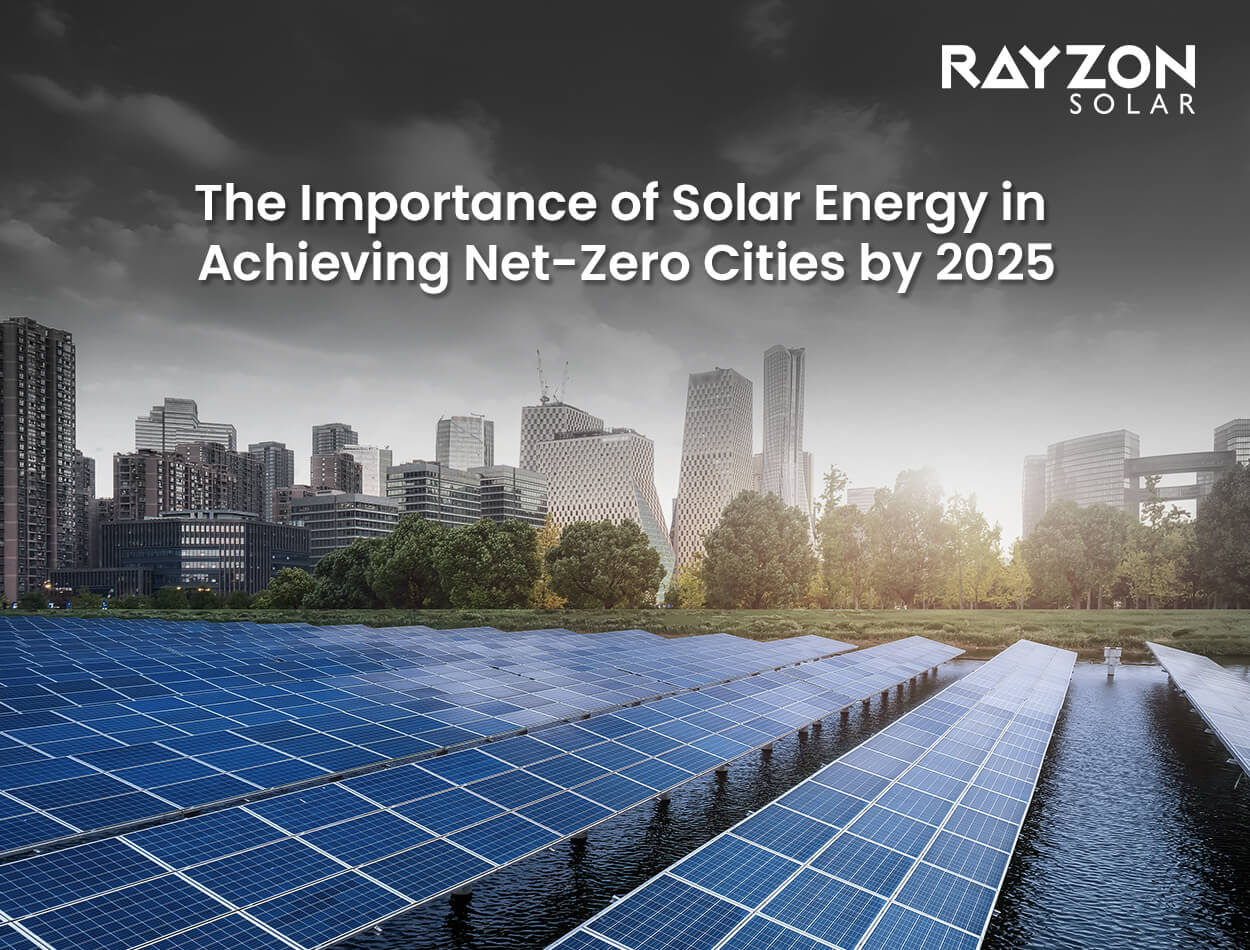
The Role of Solar in the Transition to Net-Zero Cities by 2025
The race to combat climate change has led cities across the global to embrace a bold vision: becoming Net-Zero Cities by 2025. These urban centres aim to eliminate or offset their carbon emissions, creating a sustainable environment for future generations. But achieving such an ambitious goal requires innovative solutions, with solar energy leading the charge. The solar energy transition is not just a trend but a necessity, transforming how cities power their infrastructures.
In this blog, we delve into the vital role of solar power in this global movement. From powering skyscrapers to lighting up entire neighbourhoods, solar energy is becoming the backbone of sustainable urban development. As we explore the cutting-edge technologies driving this change, we’ll also highlight the contributions of top solar panel manufacturers, like Rayzon Solar, in turning the vision of Net-Zero Cities into a reality.
Solar Energy: Driving the Transition to Net-Zero Cities
Why Solar Power?
Solar power is more than just a clean energy source; it’s the keystone of the net-zero movement. Unlike fossil fuels, which release harmful emissions, solar energy harnesses the sun’s natural power, converting it into electricity without pollution. This makes it an essential element in reducing a city's carbon footprint.
Urban centres worldwide are adopting solar technology at an unprecedented pace. From solar panels on rooftops to solar-powered public transit systems, cities are reimagining their landscapes with sustainability at the forefront. This shift is crucial for meeting the 2025 renewable energy goals, ensuring that cities can thrive while minimizing their environmental impact.
Solar Energy: A Cornerstone of Net-Zero Cities
Solar energy offers a compelling solution for cities looking to reduce their carbon emissions. It is a versatile and scalable technology that can be deployed in various urban settings, from rooftops to large-scale solar farms. By harnessing the sun's abundant energy, cities can generate clean electricity, reduce their dependence on fossil fuels, and mitigate the impacts of climate change.
Key Benefits of Solar Energy for Cities:
- Reduced Greenhouse Gas Emissions: Solar power is a carbon-free energy source, helping cities achieve their net-zero goals.
- Energy Independence: Cities can reduce their dependence on external energy sources and enhance energy security by generating their own electricity.
- Economic Benefits: Solar energy can create jobs and stimulate economic growth in the local community.
- Improved Air Quality: Solar power can help improve air quality and public health by reducing the use of fossil fuels.
Solar Integration in Urban Landscapes
Urban Solar Solutions: A New Era of City Planning
The integration of solar energy into urban infrastructure is not just about installing panels; it's about designing inherently sustainable cities. This includes everything from building facades covered in high-efficiency solar panels to solar-powered streetlights and electric vehicle charging stations.
Did You Know?
New York City aims to install 100 MW of solar panels on city-owned buildings by 2025 and expand to 150 MW by 2030, reducing its carbon footprint by 80% and advancing its sustainability goals.
Reference: New York City Council
Innovative Solar Technologies
Advancements in solar technology are making it easier for cities to incorporate solar power into their infrastructure. Bifacial solar panels, which capture sunlight from both sides, and thin-film solar panels which are flexible and lightweight, are perfect for urban environments where space is limited.
Key Solar Panel Manufacturers Driving the Net-Zero Movement
Rayzon Solar: Pioneering Urban Solar Solutions
Rayzon Solar, a leader among top solar panel manufacturers, is fronting the push toward sustainable urban energy solutions. Renowned for producing some of the best solar panels in 2024, Rayzon Solar stands out for its commitment to innovation and quality. The company's solar panels are engineered to meet the unique demands of urban environments, where space is limited and aesthetics matter. Their products are not only highly efficient but also built to withstand the tough conditions of city life, ensuring long-term reliability and performance. By focusing on advanced technologies and robust design, Rayzon Solar is making it possible for cities to harness the full potential of solar power and move closer to achieving their net-zero goals.
Top Solar Companies Driving Change
The journey to net-zero cities relies heavily on the integration of high-quality solar panels. Rayzon Solar is key in this transition, providing cutting-edge technologythat makes the vision of sustainable urban living a reality. As top solar companies, they offer not just high-efficiency solar panels but also comprehensive solutions that address various urban challenges. Their focus on continuous innovation ensures that cities have access to the best solar panel brands and technologies, facilitating the shift to clean, renewable energy. By partnering with leading solar panel manufacturers, urban areas can significantly advance their sustainability initiatives and contribute to a global movement towards a cleaner, greener future.
Success Stories and Real-world Applications
Case Study: Copenhagen’s Solar-Powered Future
Copenhagen is on track to become the world’s first net-zero city by 2025, with solar energy playing a central role. The city has implemented solar panels on various public and private buildings, generating enough electricity to power thousands of homes and significantly reducing its carbon emissions.
Copenhagen has major climate ambitions and aims to be the first carbon-neutral capital by 2025. Despite a projected 20% population growth over the next decade, the city seeks to demonstrate that economic growth and improved quality of life can coexist with significant CO2 reductions. To achieve this, the City Council adopted the ambitious CPH 2025 Climate Plan in 2012, which is based on four key pillars:
1.Energy Consumption
2.Energy Production
3.Mobility
4.City Administration Initiatives
Quick Fact:
Copenhagen’s ambitious climate plan includes integrating solar power extensively across its urban infrastructure, showcasing the effectiveness of solar energy for sustainable cities, and reinforcing the city’s commitment to becoming carbon-neutral.
Reference: https://carbonneutralcities.org/cities/copenhagen
Solar-Powered Transportation: Revolutionizing Urban Mobility
Cities like San Francisco and Paris are leading the way in integrating solar power into their public transportation systems. Solar-powered buses and trains are not only reducing emissions but also lowering energy costs, showcasing how solar energy can be applied beyond traditional uses.
Read More: Solar Energy is the Future Of Transportation
Overcoming Challenges in Solar Panel Installation
Space Constraints and Urban Planning
One of the biggest challenges in solar panel installation for cities is space. However, innovative solutions like vertical solar farms and building-integrated photovoltaics (BIPV) are helping cities overcome these obstacles. By integrating solar panels directly into building materials, cities can maximize their use of available space.
Regulatory and Financial Hurdles
While the benefits of solar power are clear, regulatory and financial barriers can slow down adoption. Cities are addressing these challenges by offering incentives for solar installations and streamlining the approval process. Partnerships with top solar companies are also crucial, providing the expertise needed to navigate complex regulations.
Looking Ahead: The Future of Net-Zero Cities
What’s Next for Urban Solar Energy?
As we approach 2025, the role of solar energy in cities will only grow. Innovations like solar windows and solar roads are already being tested, offering even more ways for cities to harness the power of the sun. These technologies will be crucial as urban populations continue to rise, increasing the demand for clean energy.
The Role of Policy and Community Engagement
Government policies and community support are essential for the continued growth of solar energy in cities. Public awareness campaigns, incentives for solar adoption, and investments in renewable energy infrastructure will all play a part in making net-zero cities a reality.
Conclusion
The transition to Net-Zero Cities by 2025 is more than an environmental goal; it’s a blueprint for a sustainable future. By embracing solar energy, cities can drastically reduce their carbon emissions and lead the way in the global fight against climate change. The integration of high-efficiency solar panels, supported by the innovations of leading manufacturers like Rayzon Solar, is transforming urban landscapes into models of sustainability.
As cities around the world continue to grow, the need for sustainable energy solutions will become even more critical. Solar power offers a path forward, enabling cities to achieve their 2025 renewable energy goals and beyond. With Rayzon Solar driving innovation, the future of urban energy is bright—and green.
For more information on how Rayzon Solar can support your urban solar projects contact us today.


